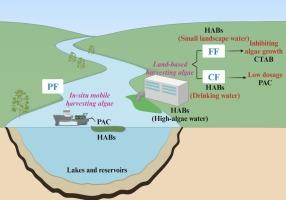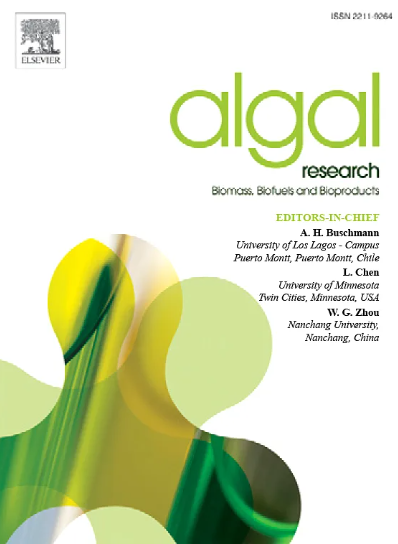A multi-dimensional comparative study on the performance of algae removal using various flotation
IF 4.6
2区 生物学
Q1 BIOTECHNOLOGY & APPLIED MICROBIOLOGY
Algal Research-Biomass Biofuels and Bioproducts
Pub Date : 2024-11-08
DOI:10.1016/j.algal.2024.103793
引用次数: 0
Abstract
Flotation is considered the most cost-effective and efficient algae-water separation technology. However, there are various flotation techniques for algae removal, such as coagulation-flotation (CF), foam flotation (FF), and positively charged bubble flotation (PF). It remains unclear which method is most suitable for removing algae from water bodies and under what specific conditions each technique is most effective. This study systematically compares CF, FF, and PF in terms of algal cell removal efficiency, concentration ratio, flotation kinetics, impact on algal cells, removal efficiency of algal organic matter (AOM), microcystins (MC-LR) and disinfection by-products (DBPs), as well as economic cost analysis. CF is better suited for algae removal in water bodies, including drinking water sources, using fixed installations on shore due to its high removal efficiency, high concentration ratio, low chemical dosage, minimal residuals, and low risk of generating DBPs. FF is more appropriate for non-drinking water sources as it can remove algae and further control algal growth; however, its residual CTAB may pose a threat to drinking water safety. PF is most suitable for in situ algae removal within water bodies, primarily because it does not require stirring or coagulation. Instead, modified bubbles can be directly introduced into the algal distribution layer, where they adhere to algal cells, facilitating algae-water separation. All three flotation methods are economically feasible for algae removal. For FF, the costs of chemicals and electricity are nearly equal, while for CF and PF, the primary cost is electricity. This study provides data to support the selection of appropriate flotation technologies for emergency removal of algal blooms in water bodies.

利用各种浮选技术去除藻类的多维比较研究
浮选被认为是最具成本效益和效率的水藻分离技术。然而,有多种浮选除藻技术,如混凝-浮选(CF)、泡沫浮选(FF)和带正电的气泡浮选(PF)。目前仍不清楚哪种方法最适合去除水体中的藻类,也不清楚每种技术在什么特定条件下最有效。本研究从藻细胞去除效率、浓度比、气浮动力学、对藻细胞的影响、藻类有机物(AOM)、微囊藻毒素(MC-LR)和消毒副产物(DBPs)的去除效率以及经济成本分析等方面对 CF、FF 和 PF 进行了系统比较。由于 CF 的去除效率高、浓缩比率高、化学药剂用量少、残留物极少、产生 DBP 的风险低,因此更适合使用岸上固定装置去除水体(包括饮用水源)中的藻类。FF 更适合用于非饮用水源,因为它可以去除藻类并进一步控制藻类的生长;但其残留的 CTAB 可能会对饮用水安全构成威胁。PF 最适合用于水体中的原位除藻,主要是因为它不需要搅拌或混凝。相反,改性气泡可以直接进入藻类分布层,并附着在藻类细胞上,促进藻水分离。这三种浮选方法都是经济可行的除藻方法。对于 FF,化学品和电力成本几乎相等,而对于 CF 和 PF,主要成本是电力。这项研究为选择适当的气浮技术来紧急清除水体中的藻华提供了数据支持。
本文章由计算机程序翻译,如有差异,请以英文原文为准。
求助全文
约1分钟内获得全文
求助全文
来源期刊

Algal Research-Biomass Biofuels and Bioproducts
BIOTECHNOLOGY & APPLIED MICROBIOLOGY-
CiteScore
9.40
自引率
7.80%
发文量
332
期刊介绍:
Algal Research is an international phycology journal covering all areas of emerging technologies in algae biology, biomass production, cultivation, harvesting, extraction, bioproducts, biorefinery, engineering, and econometrics. Algae is defined to include cyanobacteria, microalgae, and protists and symbionts of interest in biotechnology. The journal publishes original research and reviews for the following scope: algal biology, including but not exclusive to: phylogeny, biodiversity, molecular traits, metabolic regulation, and genetic engineering, algal cultivation, e.g. phototrophic systems, heterotrophic systems, and mixotrophic systems, algal harvesting and extraction systems, biotechnology to convert algal biomass and components into biofuels and bioproducts, e.g., nutraceuticals, pharmaceuticals, animal feed, plastics, etc. algal products and their economic assessment
 求助内容:
求助内容: 应助结果提醒方式:
应助结果提醒方式:


